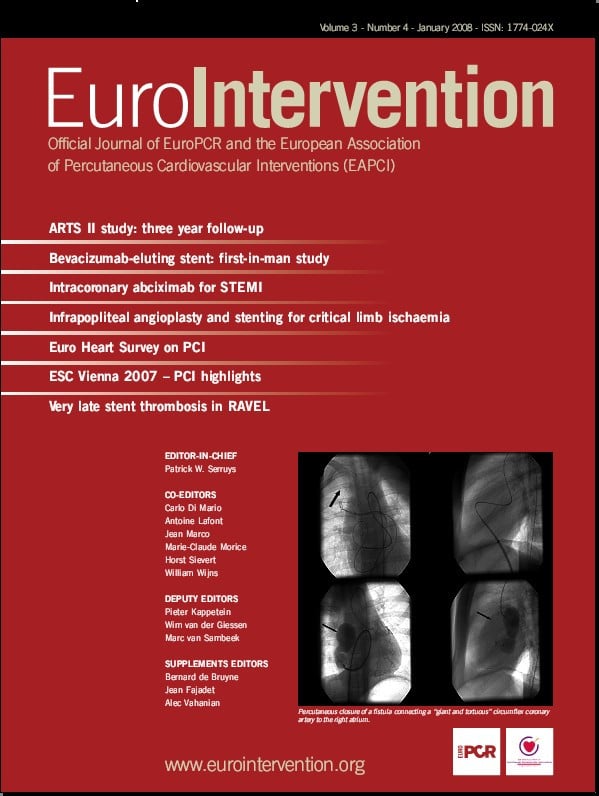As the EAPCI continues to evolve and define its role within the community, it finds itself naturally at the centre of a vast amount of information generated by – and for – the profession. Finding ourselves at the crossroads in this information highway brings with it the further responsibility seeing our role evolve, either in the direction of a simple clearing house for this information, or, in some way that needs yet to be fully determined, the guarantee, or at least measure of its quality and content. In the last EuroIntervention, we discussed and noted the various educational programmes being developed with the support of industry, and here today we see another aspect, an epidemiological one, that requires continued attention, vigilance, and definition.
In this issue of EuroIntervention you will find two articles, the first on “Percutaneous coronary interventions in Europe in 2005” and the other, entitled “An insight into the current use of drug eluting stents in acute and elective percutaneous coronary interventions in Europe. A report on the EuroPCI Survey.”
Both of these two articles represent two well know European registries, one being the long standing effort on behalf of the former European Society of Cardiology (ESC) Working Group led by Bernhard Meier based on numbers provided by national interventional working groups, the second, being the primary report of the EuroHeart Survey aimed at assessing PCI practice across Europe, including the use of drug eluting stents (DES) and passive stents in patients undergoing percutaneous coronary interventions (PCI). Over 9,000 patients have now been included in the European Heart Survey. There has been, and continues to be, considerable interest in these registries both on a country-to-country, as well European level via the ESC as well as internationally.
The essence of Registries
The extraction of meaning from the various registries can be daunting, and while few doubt their critical importance, their utility requires some further reflection. As we examine and attempt to interpret them, it becomes clear that while it may be perfectly natural that there are different objectives on behalf of the different stakeholders – whether they be the companies, regulatory bodies, evaluation of practices, quality control, reimbursement, etc. – that this is a situation that needs to be truly ordered so that we might reap the greatest benefit. Similarly, methodology, definitions and quality can differ greatly from one registry to the next ranging from the “simple” collection of the number of procedures (as in Berhnard Meier’s ) to the most difficult today, which investigate long term follow-up with clinical outcomes.
As we face this onslaught of data the need for standardisation remains omnipresent. It was a little over three years ago, at the end of 2004, that we took a great step in that direction with the publication of “The Cardiology Audit and Registration Data Standards (CARDS)”1; but still, specific questions cannot be fully addressed until something as fundamental as case report forms (CRF) are prospectively designed to ask the right questions and collect the data that we truly need.
What will the future be measured by?
In the foreseeable future our need for large long-term, patient-based data collections with predetermined questions, should remain the same as today, if not increase in importance – especially if these data sets are independent of direct industry involvement. In themselves, registries provide an incentive for participating sites and can act as a spur to quality and further the idea of benchmarking. It seems probable, both in terms of efficient interpretation and independence, that these national efforts should be coordinated and pooled at the European level, eventually even facilitated by the EAPCI itself.
There is a lack of wisdom in continually multiplying separate initiatives which can only further dilute our efforts and evade clear responses. Separate registries should seek a common denominator so that their results can be pooled, and clearly analysed, thus augmenting their pertinence.
Funding will probably remain a major issue because a good registry done in an exhaustive and correct way comes with a certain price tag which can be considerable. Source verification, development and assessment of the CRF, statistical analysis, adjudication of events, all these play into the overall budgets of these registries. At the same time, we cannot expect that industry will continue to pay for all this, nor should they. European Union (EU) funds, national governments and health care providers need to step into this field because so many of the issues elucidated in these registries go far beyond simple device questions; one recent example, the Syntax trial, cost Boston Scientific over 40,000,000 euros and will touch on far more than this companies main products; to name only a few, what are our needs concerning the training of operators, what is the availability of operating versus catheterisation rooms, etc.
Like guidelines, registries are continuing to grow in number, and like guidelines, their usefulness in making sense out of our complex world remains valid. The EAPCI has a challenge to take up a leadership role, and become the natural forum for discussions leading to the design, implementation, and referencing helping to insure that these registries remain valuable tools.
Reference

